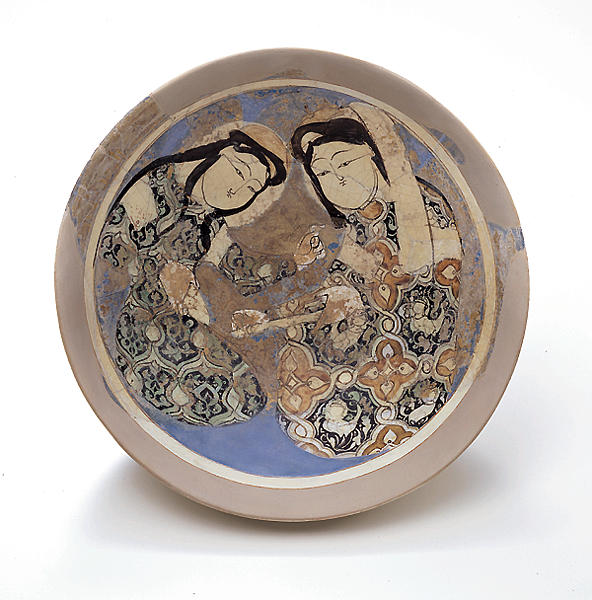青地色絵奏楽図鉢
- イラン
- セルジューク朝時代
- 12-13c
- 複合陶土
- H-8.6 D-21
草花文や人面鳥身のハルピュイア(アンカア)が織り成された豪華な衣装や円形の頭光を見ると、描かれた2人が高貴な人物だということが分かる。イスラムの工匠は写実に対する関心が薄いため、判定が難しいが、右側の人物は竪琴を持ち、左の人物は花束を手にしている。右側に赤で縁取りして金彩を施した草が長く伸びているのでこの情景が戸外であることがわかる。
Catalogue Entry
Owing to a great deal of restoration, the details of this bowl are not very clear. Two figures--beautifully dressed, facing each other, and enjoying music--fill the entire bowl. The Freer Gallery of Art, Smithsonian Institution, Washington, D.C., contains a piece that is extraordinarily similar in style, in which the beards, crowns, personal accessories, and hair ornaments are much more clearly depicted than in the Shumei example.1 It is difficult to establish the social position of the two figures here, but judging from the floral patterns, the harpies with human faces and bird bodies woven into the magnificent garments, and the headpieces and haloes surrounding their heads, there is no doubt that they are royalty. The eyes are gracefully elongated, while the tiny mouths and the fullness of the cheeks remind one of the figures seen in the miniatures by an artist from Azerbaijan illustrating the story of Varqa va Galshah from the same period.2 In general, Islamic artisans tend to eschew realism, so it is difficult to establish the age or sex of these figures. The one on the right is holding a harp, while the one on the left is holding a bouquet of flowers; the right-hand figure is outlined in red, and gold is used on the flowing floral motifs that set off an outdoor musical scene.
In their southward move from Central Asia onto the Iranian plateau, the Seljuq Turkish tribes provided a great stimulus to the development of Persian arts and crafts, resulting in the flowering of various crafts, including ceramics and metalwork. From the latter half of the twelfth century through the early thirteenth century, there was a remarkable change in Persian ceramics especially, taking in all aspects of subject matter, form, style, and technique. Decorative techniques included luster, overglaze painting, underglaze painting, molding, piercing, and gilding. In subject matter, activities of royalty took precedence, along with traditional tales of royal personages. Mysticism supplied religious subjects, and themes concerning common people can also be found, indicating that the period's creative movement resulted from the revitalization brought about by Islam. However, mina'i ware with overglaze painting such as that on this piece was short-lived in comparison with lusterware. According to records left by contemporary potters, by the year 130l this technique was already in decline.3
TS
1. Oriental Ceramics 1975, color pl. 90; Atil l973, nos. 41, 42; Mikami 1986, pl. 156 (Walters Art Gallery, Baltimore).
2. Grube 1978, pls. 2\-5.
3. Allan 1973.
